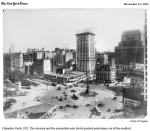[Have a look at this good historical piece by Christopher Gray which appeared in today's New York Times under their Streetscapes/Traffic Wars rubric.] IN the future, perhaps our time will be known as the first decade of the Bicycle Wars, with righteous armies fighting over traffic lanes, bike paths and sidewalks, indeed over the very purpose of the streets themselves. Like many wars, it’s a question of territory, and the pedestrian has been losing for years.
IN the future, perhaps our time will be known as the first decade of the Bicycle Wars, with righteous armies fighting over traffic lanes, bike paths and sidewalks, indeed over the very purpose of the streets themselves. Like many wars, it’s a question of territory, and the pedestrian has been losing for years.
The Pedestrian Loses the Way
- Christopher Gray, New York Times, 10 Nov. 2011
For centuries, pedestrians had undifferentiated dominion over both the sidewalks and the roadbed — sidewalks were not pedestrian cattle pens, but off-limits zones for vehicles. “The street” meant the entire open area, from building line to building line.
This changed in the 1880s with the advent of electric and cable streetcars, with their much greater weights and speeds than horse-drawn vehicles, not to mention their guillotine-like wheels. It is a comment on how we viewed our streets that, by design, passengers were meant to board streetcars in the middle of the roadway.
This changed in the 1880s with the advent of electric and cable streetcars, with their much greater weights and speeds than horse-drawn vehicles, not to mention their guillotine-like wheels. It is a comment on how we viewed our streets that, by design, passengers were meant to board streetcars in the middle of the roadway.
But the installation of trolley tracks also created a kill zone. In 1894 The New York Times reported that a speeding streetcar on Prospect Avenue in Brooklyn had killed 10-year-old Theodore Cox, “a bright little boy” who was “ground under the wheels.” The police helped the motorman escape the crowd, which was crying “Lynch him!” This was not to be a bloodless war.
The pedestrian’s domain was further challenged by the decade-long bicycle fad of the 1890s. In 1893, when The Times described upper Broadway as “a regular race track” for speeding cyclists, one of them, operating without bell or whistle, killed 7-year-old Katie McGlynn just as she was exiting a streetcar at Broadway and 67th. “They make no noise and go by you with a rush,” said Police Capt. Elbert Smith. “You shout at them to slow down, but they are off before you know it.” But the fashion for bicycles soon waned.
* * * Click here to read the full text of this article in today's NY Times.
# # #
About the author:
Christopher Gray has been writing the Streetscapes column since 1987. He writes this about himself and his work: "When I am roughing out a story I really
 am looking for three things. First, and most fun, is a good, sharp historic photograph - I could never portray the city of the past as clearly as a picture that shows the lack of automobiles, the changes in signage, the types of curtains, how people stand on the street - really the warp and woof of New York. Then, I am always looking for people - the buildings I write about are not artifacts of architectural style. Rather, each is a maelstrom of humanity: developers, architects, regulators, lenders, tenants, servants, shop keepers, and each of them has a piece of the action. And, finally, I am generally looking for some way to make the subject relevant to the present - how is this structure a lens through which to see our own time? For instance, following the attacks of Sept. 11th, I wondered what it was like in New York after Dec. 7, 1941. The patterns and networks of architecture and real estate in this city are so wide and deep that they seem endless. It's been about a thousand columns since Mike Sterne took a leap of faith and hired me 21 years ago. There are thousands more to write."
am looking for three things. First, and most fun, is a good, sharp historic photograph - I could never portray the city of the past as clearly as a picture that shows the lack of automobiles, the changes in signage, the types of curtains, how people stand on the street - really the warp and woof of New York. Then, I am always looking for people - the buildings I write about are not artifacts of architectural style. Rather, each is a maelstrom of humanity: developers, architects, regulators, lenders, tenants, servants, shop keepers, and each of them has a piece of the action. And, finally, I am generally looking for some way to make the subject relevant to the present - how is this structure a lens through which to see our own time? For instance, following the attacks of Sept. 11th, I wondered what it was like in New York after Dec. 7, 1941. The patterns and networks of architecture and real estate in this city are so wide and deep that they seem endless. It's been about a thousand columns since Mike Sterne took a leap of faith and hired me 21 years ago. There are thousands more to write."# # #
Kind thanks to John W. Verity for the heads-op.
_____________________________________________________
 Print this article
Print this article



No comments:
Post a Comment
Thank you for your comment. You may wish to check back to the original entry from time to time to see if there are reactions to this. If you have questions, send an email to: editor@worldstreets.org